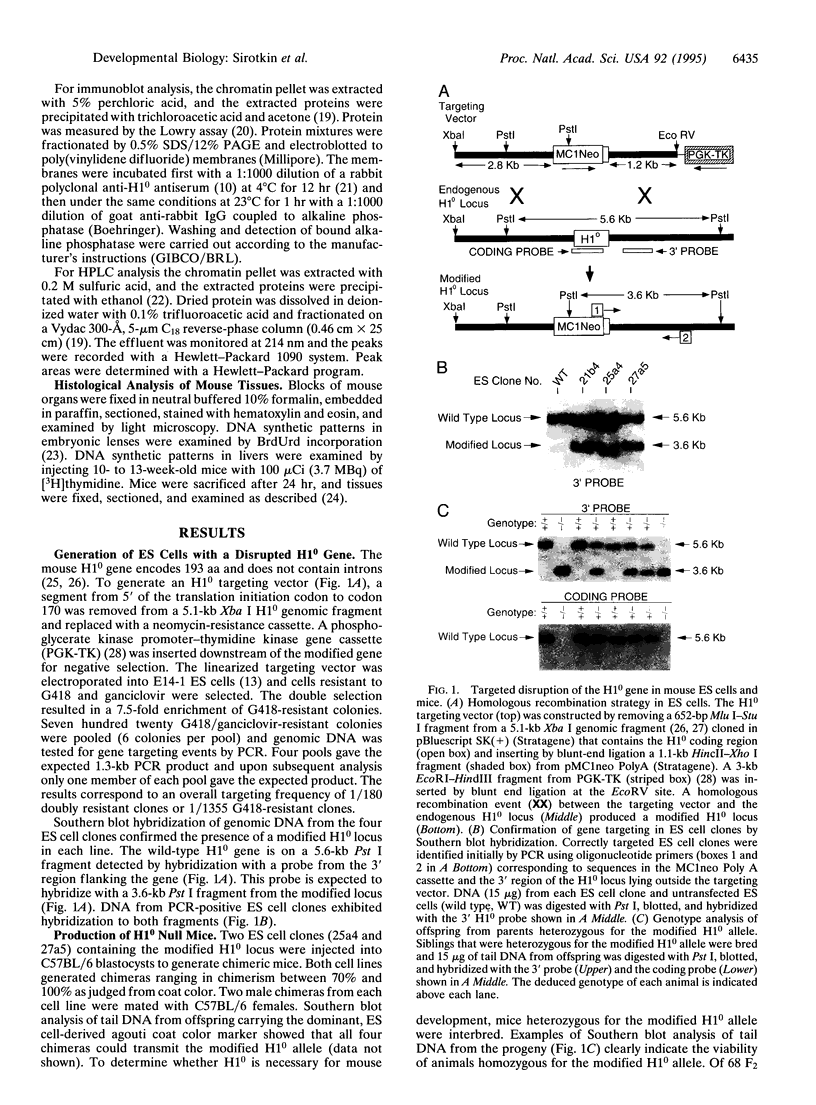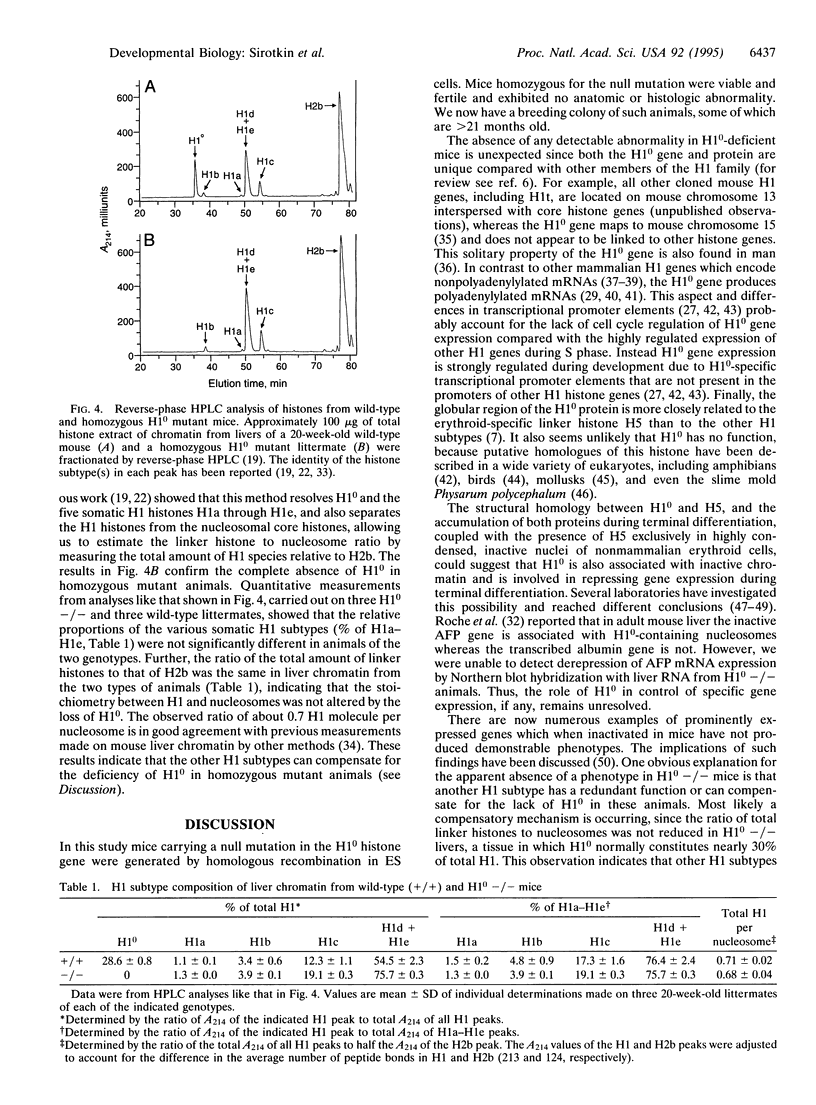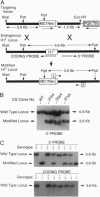Abstract
H1 histones bind to the linker DNA between nucleosome core particles and facilitate the folding of chromatin into a 30-nm fiber. Mice contain at least seven nonallelic subtypes of H1, including the somatic variants H1a through H1e, the testis-specific variant H1t, and the replacement linker histone H1(0). H1(0) accumulates in terminally differentiating cells from many lineages, at about the time when the cells cease dividing. To investigate the role of H1(0) in development, we have disrupted the single-copy H1(0) gene by homologous recombination in mouse embryonic stem cells. Mice homozygous for the mutation and completely lacking H1(0) mRNA and protein grew and reproduced normally and exhibited no anatomic or histologic abnormalities. Examination of tissues in which H1(0) is normally present at high levels also failed to reveal any abnormality in cell division patterns. Chromatin from H1(0)-deficient animals showed no significant change in the relative proportions of the other H1 subtypes or in the stoichiometry between linker histones and nucleosomes, suggesting that the other H1 histones can compensate for the deficiency in H1(0) by occupying sites that normally contain H1(0). Our results indicate that despite the unique properties and expression pattern of H1(0), its function is dispensable for normal mouse development.
Full text
PDF




Images in this article
Selected References
These references are in PubMed. This may not be the complete list of references from this article.
- Albig W., Drabent B., Kunz J., Kalff-Suske M., Grzeschik K. H., Doenecke D. All known human H1 histone genes except the H1(0) gene are clustered on chromosome 6. Genomics. 1993 Jun;16(3):649–654. doi: 10.1006/geno.1993.1243. [DOI] [PubMed] [Google Scholar]
- Albig W., Kardalinou E., Drabent B., Zimmer A., Doenecke D. Isolation and characterization of two human H1 histone genes within clusters of core histone genes. Genomics. 1991 Aug;10(4):940–948. doi: 10.1016/0888-7543(91)90183-f. [DOI] [PubMed] [Google Scholar]
- Alonso A., Breuer B., Bouterfa H., Doenecke D. Early increase in histone H1(0) mRNA during differentiation of F9 cells to parietal endoderm. EMBO J. 1988 Oct;7(10):3003–3008. doi: 10.1002/j.1460-2075.1988.tb03163.x. [DOI] [PMC free article] [PubMed] [Google Scholar]
- Auffray C., Rougeon F. Purification of mouse immunoglobulin heavy-chain messenger RNAs from total myeloma tumor RNA. Eur J Biochem. 1980 Jun;107(2):303–314. doi: 10.1111/j.1432-1033.1980.tb06030.x. [DOI] [PubMed] [Google Scholar]
- Bates D. L., Thomas J. O. Histones H1 and H5: one or two molecules per nucleosome? Nucleic Acids Res. 1981 Nov 25;9(22):5883–5894. doi: 10.1093/nar/9.22.5883. [DOI] [PMC free article] [PubMed] [Google Scholar]
- Brannan C. I., Gilbert D. J., Ceci J. D., Matsuda Y., Chapman V. M., Mercer J. A., Eisen H., Johnston L. A., Copeland N. G., Jenkins N. A. An interspecific linkage map of mouse chromosome 15 positioned with respect to the centromere. Genomics. 1992 Aug;13(4):1075–1081. doi: 10.1016/0888-7543(92)90021-j. [DOI] [PubMed] [Google Scholar]
- Breuer B., Steuer B., Alonso A. Basal level transcription of the histone H1(0) gene is mediated by a 80 bp promoter fragment. Nucleic Acids Res. 1993 Feb 25;21(4):927–934. doi: 10.1093/nar/21.4.927. [DOI] [PMC free article] [PubMed] [Google Scholar]
- Brocard M. P., Rousseau D., Lawrence J. J., Khochbin S. Two mRNA species encoding the differentiation-associated histone H1(0) are produced by alternative polyadenylation in mouse. Eur J Biochem. 1994 Apr 1;221(1):421–425. doi: 10.1111/j.1432-1033.1994.tb18754.x. [DOI] [PubMed] [Google Scholar]
- Brown D. T., Sittman D. B. Identification through overexpression and tagging of the variant type of the mouse H1e and H1c genes. J Biol Chem. 1993 Jan 5;268(1):713–718. [PubMed] [Google Scholar]
- Cheng G. H., Skoultchi A. I. Rapid induction of polyadenylated H1 histone mRNAs in mouse erythroleukemia cells is regulated by c-myc. Mol Cell Biol. 1989 Jun;9(6):2332–2340. doi: 10.1128/mcb.9.6.2332. [DOI] [PMC free article] [PubMed] [Google Scholar]
- Delabar J. M. Nonrandom location of H1-H1 degree histones on chromatin of mouse liver and brain. J Biol Chem. 1985 Oct 15;260(23):12622–12628. [PubMed] [Google Scholar]
- Doenecke D., Albig W., Bouterfa H., Drabent B. Organization and expression of H1 histone and H1 replacement histone genes. J Cell Biochem. 1994 Apr;54(4):423–431. doi: 10.1002/jcb.240540409. [DOI] [PubMed] [Google Scholar]
- Doenecke D., Tönjes R. Differential distribution of lysine and arginine residues in the closely related histones H1 and H5. Analysis of a human H1 gene. J Mol Biol. 1986 Feb 5;187(3):461–464. doi: 10.1016/0022-2836(86)90446-8. [DOI] [PubMed] [Google Scholar]
- Dong Y., Liu D., Skoultchi A. I. An upstream control region required for inducible transcription of the mouse H1(zero) histone gene during terminal differentiation. Mol Cell Biol. 1995 Apr;15(4):1889–1900. doi: 10.1128/mcb.15.4.1889. [DOI] [PMC free article] [PubMed] [Google Scholar]
- Dong Y., Sirotkin A. M., Yang Y. S., Brown D. T., Sittman D. B., Skoultchi A. I. Isolation and characterization of two replication-dependent mouse H1 histone genes. Nucleic Acids Res. 1994 Apr 25;22(8):1421–1428. doi: 10.1093/nar/22.8.1421. [DOI] [PMC free article] [PubMed] [Google Scholar]
- Drabent B., Kardalinou E., Doenecke D. Structure and expression of the human gene encoding testicular H1 histone (H1t). Gene. 1991 Jul 22;103(2):263–268. doi: 10.1016/0378-1119(91)90284-i. [DOI] [PubMed] [Google Scholar]
- Erickson H. P. Gene knockouts of c-src, transforming growth factor beta 1, and tenascin suggest superfluous, nonfunctional expression of proteins. J Cell Biol. 1993 Mar;120(5):1079–1081. doi: 10.1083/jcb.120.5.1079. [DOI] [PMC free article] [PubMed] [Google Scholar]
- Fodde R., Edelmann W., Yang K., van Leeuwen C., Carlson C., Renault B., Breukel C., Alt E., Lipkin M., Khan P. M. A targeted chain-termination mutation in the mouse Apc gene results in multiple intestinal tumors. Proc Natl Acad Sci U S A. 1994 Sep 13;91(19):8969–8973. doi: 10.1073/pnas.91.19.8969. [DOI] [PMC free article] [PubMed] [Google Scholar]
- GRISHAM J. W. A morphologic study of deoxyribonucleic acid synthesis and cell proliferation in regenerating rat liver; autoradiography with thymidine-H3. Cancer Res. 1962 Aug;22:842–849. [PubMed] [Google Scholar]
- Gjerset R., Gorka C., Hasthorpe S., Lawrence J. J., Eisen H. Developmental and hormonal regulation of protein H1 degrees in rodents. Proc Natl Acad Sci U S A. 1982 Apr;79(7):2333–2337. doi: 10.1073/pnas.79.7.2333. [DOI] [PMC free article] [PubMed] [Google Scholar]
- Gjerset R., Ibarrando F., Saragosti S., Eisen H. Distribution of IP25 in chromatin and its possible involvement in chromatin condensation. Biochem Biophys Res Commun. 1981 Mar 31;99(2):349–357. doi: 10.1016/0006-291x(81)91752-6. [DOI] [PubMed] [Google Scholar]
- Helliger W., Lindner H., Grübl-Knosp O., Puschendorf B. Alteration in proportions of histone H1 variants during the differentiation of murine erythroleukaemic cells. Biochem J. 1992 Dec 15;288(Pt 3):747–751. doi: 10.1042/bj2880747. [DOI] [PMC free article] [PubMed] [Google Scholar]
- Keppel F., Allet B., Eisen H. Appearance of a chromatin protein during the erythroid differentiation of Friend virus-transformed cells. Proc Natl Acad Sci U S A. 1977 Feb;74(2):653–656. doi: 10.1073/pnas.74.2.653. [DOI] [PMC free article] [PubMed] [Google Scholar]
- Khochbin S., Wolffe A. P. Developmental regulation and butyrate-inducible transcription of the Xenopus histone H1(0) promoter. Gene. 1993 Jun 30;128(2):173–180. doi: 10.1016/0378-1119(93)90560-p. [DOI] [PubMed] [Google Scholar]
- LOWRY O. H., ROSEBROUGH N. J., FARR A. L., RANDALL R. J. Protein measurement with the Folin phenol reagent. J Biol Chem. 1951 Nov;193(1):265–275. [PubMed] [Google Scholar]
- Lennox R. W., Cohen L. H. The histone H1 complements of dividing and nondividing cells of the mouse. J Biol Chem. 1983 Jan 10;258(1):262–268. [PubMed] [Google Scholar]
- Lindner H., Helliger W., Dirschlmayer A., Jaquemar M., Puschendorf B. High-performance capillary electrophoresis of core histones and their acetylated modified derivatives. Biochem J. 1992 Apr 15;283(Pt 2):467–471. doi: 10.1042/bj2830467. [DOI] [PMC free article] [PubMed] [Google Scholar]
- Mendelson E., Landsman D., Druckmann S., Bustin M. Immunofractionation of chromatin regions associated with histone H1o. Eur J Biochem. 1986 Oct 15;160(2):253–260. doi: 10.1111/j.1432-1033.1986.tb09964.x. [DOI] [PubMed] [Google Scholar]
- Miloshev G., Zlatanova J., Srebreva L., Tsanev R. Presence of a H1o-type histone in an invertebrate--the bivalve mollusc Anodonta cygnea. Comp Biochem Physiol B. 1985;82(4):759–761. doi: 10.1016/0305-0491(85)90521-8. [DOI] [PubMed] [Google Scholar]
- Morgenbesser S. D., Williams B. O., Jacks T., DePinho R. A. p53-dependent apoptosis produced by Rb-deficiency in the developing mouse lens. Nature. 1994 Sep 1;371(6492):72–74. doi: 10.1038/371072a0. [DOI] [PubMed] [Google Scholar]
- Panyim S., Chalkley R. A new histone found only in mammalian tissues with little cell division. Biochem Biophys Res Commun. 1969 Dec 4;37(6):1042–1049. doi: 10.1016/0006-291x(69)90237-x. [DOI] [PubMed] [Google Scholar]
- Paranjape S. M., Kamakaka R. T., Kadonaga J. T. Role of chromatin structure in the regulation of transcription by RNA polymerase II. Annu Rev Biochem. 1994;63:265–297. doi: 10.1146/annurev.bi.63.070194.001405. [DOI] [PubMed] [Google Scholar]
- Pehrson J. R., Cole R. D. Histone H1 subfractions and H10 turnover at different rates in nondividing cells. Biochemistry. 1982 Feb 2;21(3):456–460. doi: 10.1021/bi00532a006. [DOI] [PubMed] [Google Scholar]
- Pehrson J., Cole R. D. Histone H10 accumulates in growth-inhibited cultured cells. Nature. 1980 May 1;285(5759):43–44. doi: 10.1038/285043a0. [DOI] [PubMed] [Google Scholar]
- Roche J., Gorka C., Goeltz P., Lawrence J. J. Association of histone H1(0) with a gene repressed during liver development. Nature. 1985 Mar 14;314(6007):197–198. doi: 10.1038/314197a0. [DOI] [PubMed] [Google Scholar]
- Rudnicki M. A., Braun T., Hinuma S., Jaenisch R. Inactivation of MyoD in mice leads to up-regulation of the myogenic HLH gene Myf-5 and results in apparently normal muscle development. Cell. 1992 Oct 30;71(3):383–390. doi: 10.1016/0092-8674(92)90508-a. [DOI] [PubMed] [Google Scholar]
- Srebreva L. N., Andreeva N. B., Gasaryan K. G., Tsanev R. G., Zlatanova J. S. Presence of histone H1o-related fraction in chicken liver. Differentiation. 1983;25(2):113–120. doi: 10.1111/j.1432-0436.1984.tb01347.x. [DOI] [PubMed] [Google Scholar]
- Varricchio F., Mabogunje O., Kim D., Fortner J. G., Fitzgerald P. J. Pancreas acinar cell regeneration and histone (H1 and H10) modifications after partial pancreatectomy or after a protein-free ethionine regimen. Cancer Res. 1977 Nov;37(11):3964–3969. [PubMed] [Google Scholar]
- Workman J. L., Buchman A. R. Multiple functions of nucleosomes and regulatory factors in transcription. Trends Biochem Sci. 1993 Mar;18(3):90–95. doi: 10.1016/0968-0004(93)90160-o. [DOI] [PubMed] [Google Scholar]
- Xu L., Morgenbesser S. D., DePinho R. A. Complex transcriptional regulation of myc family gene expression in the developing mouse brain and liver. Mol Cell Biol. 1991 Dec;11(12):6007–6015. doi: 10.1128/mcb.11.12.6007. [DOI] [PMC free article] [PubMed] [Google Scholar]
- Yasuda H., Mueller R. D., Logan K. A., Bradbury E. M. Identification of histone H1(0) in Physarum polycephalum. Its high level in the plasmodial stage increases in amount and phosphorylation in the sclerotial stage. J Biol Chem. 1986 Feb 15;261(5):2349–2354. [PubMed] [Google Scholar]
- Zlatanova J., Doenecke D. Histone H1 zero: a major player in cell differentiation? FASEB J. 1994 Dec;8(15):1260–1268. doi: 10.1096/fasebj.8.15.8001738. [DOI] [PubMed] [Google Scholar]





